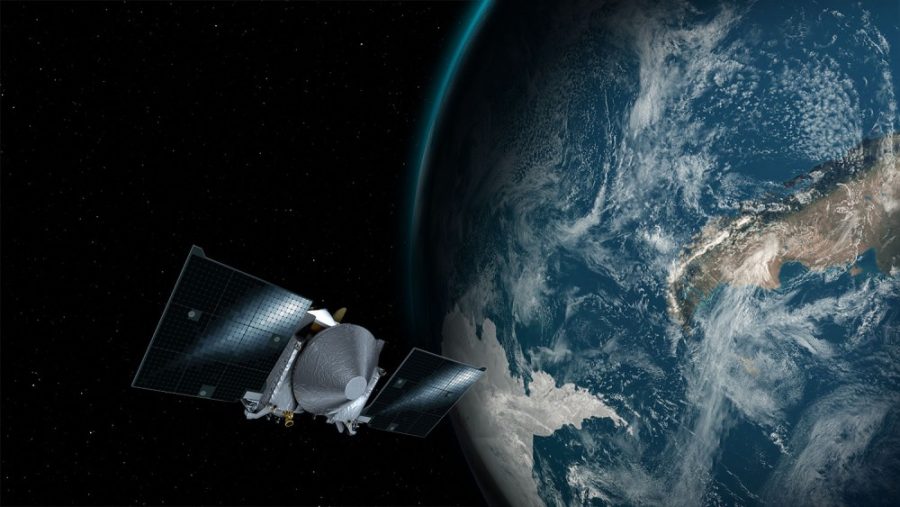On the morning of Sept. 22, OSIRIS-REx — NASA’s asteroid-hunting spacecraft —passed under the Earth at just 10,711 miles over Antarctica. The craft continued northward, as it successfully completed the next major milestone of the project: The Earth Gravity Assist.
A year ago, on Sept. 8, 2016, the “Origins, Spectral Interpretation, Resource Identification, Security-Regolith Explorer” (OSIRIS-REx) launched from Cape Canaveral, Florida and began the first step of its journey towards a nearby, primitive asteroid named Bennu.
Bennu is a smallish, dark asteroid that was selected primarily for its proximity to Earth, requiring only a small change in OSIRIS-REx’s velocity to reach it.
Furthermore, Bennu is spinning slowly enough that the surface of the asteroid is still covered with dust, soil, broken rock and other materials. This surface is known as regolith, and collecting a sample of it is the primary objective of OSIRIS-REx.
“The mission is a sample return mission,” said Dante Lauretta, principal investigator for the project. “We’re there to go get material from the surface of the asteroid and bring it back to the Earth for analysis.”
RELATED: Facing the facts: the advance of facial recognition software
However, to get to Bennu, OSIRIS-REx first needed some help from the Earth to perform a spacefaring maneuver known as an Earth Gravity Assist.
“We decided to use nature to help us get to our destination,” said Heather Enos, deputy principal investigator for the project. “We used the earth’s gravity to change the spacecraft’s orbital plane by approximately 6 degrees in order to match [Bennu].”
By flying so close to Earth, OSIRIS-REx used the gravitational field to be pulled towards the planet where it “borrowed” a small amount of Earth’s orbital energy. This additional energy was used to increase OSIRIS-REx’s orbital inclination and sling it back into space for a rendezvous with Bennu.
In layman’s terms, OSIRIS-REx used the Earth as a massive, gravitational slingshot.
 Besides readjusting the spacecraft’s trajectory, OSIRIS-REx’s team also used the close fly-by as an opportunity to test and calibrate their suite of on-board instruments using a “known target,” specifically, the Earth.
Besides readjusting the spacecraft’s trajectory, OSIRIS-REx’s team also used the close fly-by as an opportunity to test and calibrate their suite of on-board instruments using a “known target,” specifically, the Earth.
By testing the cameras, altimeters and spectrometers on Earth, the team can straighten out any potential issues the craft might encounter when attempting to scan Bennu. As luck would have it, initial readings from the instruments are not only looking good, they’re exceeding expectation, according to Lauretta.
“We have built a very capable vehicle,” Lauretta said. “It is doing everything we have designed it to do, and in fact, the performance of the science instruments is exceeding our expectations.”
 The trip to Bennu will take a little less than a year to complete, and in August 2018, Bennu will be close enough. The team will then be able to use OSIRIS-REx’s imaging capabilities and an array of small rocket thrusters to guide the craft close enough to scan the surface of the asteroid and begin the extensive process of locating a suitable sample site.
The trip to Bennu will take a little less than a year to complete, and in August 2018, Bennu will be close enough. The team will then be able to use OSIRIS-REx’s imaging capabilities and an array of small rocket thrusters to guide the craft close enough to scan the surface of the asteroid and begin the extensive process of locating a suitable sample site.
This process of choosing a site is scheduled to take almost two years, but in July 2020, OSIRIS-REx will move into position to collect the sample. However, the craft will never land on the asteroid, instead it will float, just centimeters above the surface.
“We’re hovering, almost touching it,” said Sara Knutson, OSIRIS-REx’s science operations lead engineer. “We’ll gather the soil inside the sample collection capsule and quickly move away from the asteroid so that if there’s anything flying off that we might have kicked up, we are protected from it.”
RELATED: Water purification truck works to show safety of purified waste water
The team said they’re hoping to collect the sample on the first try, but OSIRIS-REx is equipped with enough reserve fuel to make three attempts. Once the sample is collected, it will be stowed in the Sample Return Capsule for the trip back to Earth.
OSIRIS-REx will then linger for nearly a year, awaiting the correct window of departure from Bennu, in March 2021. This will place OSIRIS-REx on a trajectory that is scheduled to intersect Earth’s orbit in Sept. 2023 where it will jettison the collected sample downwards to the Earth to be retrieved by the science team.
“There were many, many months and years that went into planning this event and the team came together in a spectacular fashion,” Lauretta said. “Everything went off flawlessly, and the best days are still ahead of us.”
Follow The Daily Wildcat on Twitter









